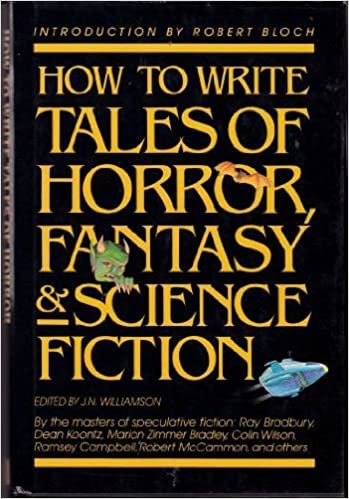First, a different kind of how-to-write book; each chapter is written by a different notable in the field – Williamson, Bradbury, Tem, Grant, Bradley, …
The variety of perspectives is interesting. I wonder if each author chose their chapter subject or were assigned it by Williamson, who served as editor.
Bradbury’s chapter, for example, is about where ideas come from and nurturing them, not specific techniques. Tem and Castle each take a turn at character but each from their own perspective.
Bradley’s “World Building in Horror, Occult, and Fantasy Writing” marks the first time I’ve seen the “world building” term outside of writers’ cons (I’m hosting a World Building panel at LitCon 2021).
Beyond chapters on technique – Plot, Character, Setting, World Building, Revision, Submission, … – How to Write Tales of Horror, Fantasy & Science Fiction‘s contributors explain the whys of their suggestions. Example: William F. Nolan’s “Involving Your Reader from the Start” chapter contains several examples of opening paragraphs (I don’t agree that all of them are good). Near the end of his chapter he writes “In the no-TV, no-video, no-comics world of Charles Dickens, readers were conditioned to deal with complex, dense, often-wordy opening pages in books and stories. It was an era of leisurely reading when the pace could be slow and unhurried. Not so today. …”
In other words, writing evolves with a purpose. Yes, there are fads and they pass quickly. What survives is what out-competes others in the environment.
Amazing how evolutionary science affects everything, isn’t it?
Greetings! I’m your friendly, neighborhood Threshold Guardian. This is a protected post. Protected posts in the My Work, Marketing, and StoryCrafting categories require a subscription (starting at 1$US/month) to access. Protected posts outside those categories require a General (free) membership.
Members and Subscribers can LogIn. Non members can join. Non-protected posts (there are several) are available to everyone.
Want to learn more about why I use a subscription model? Read More ch-ch-ch-ch-Changes Enjoy!

